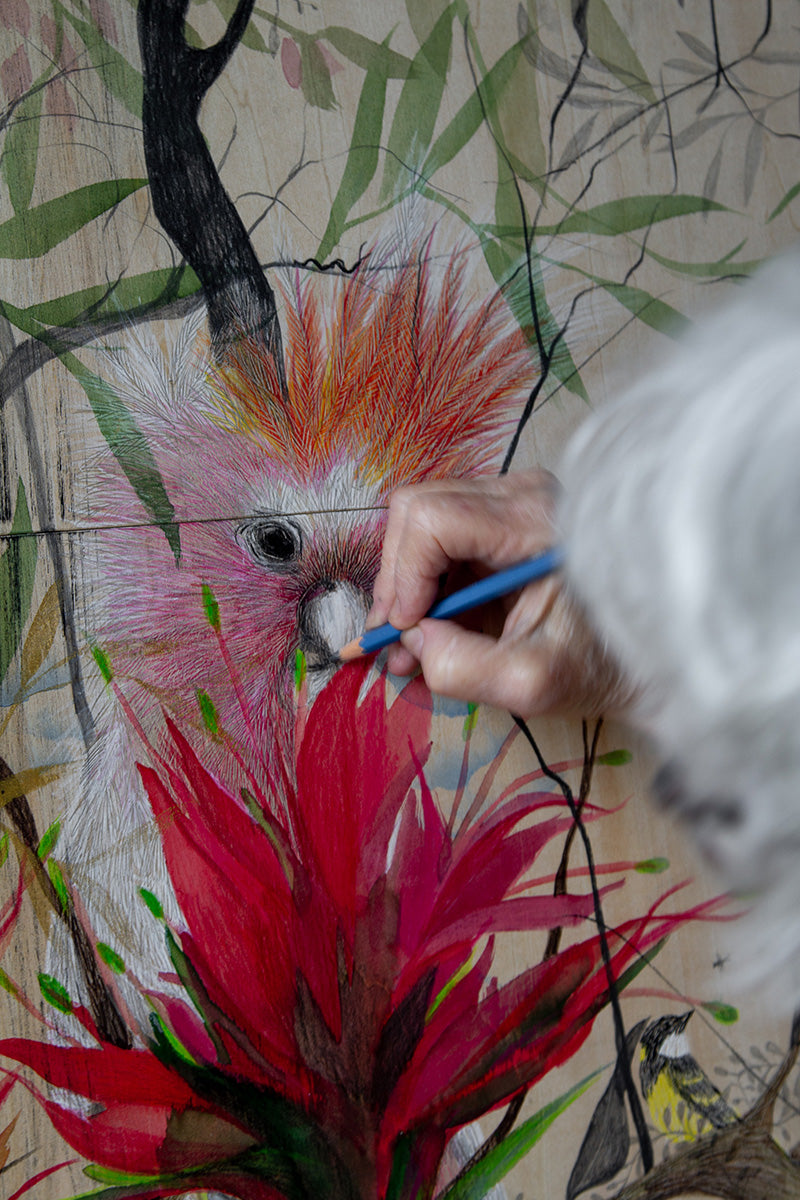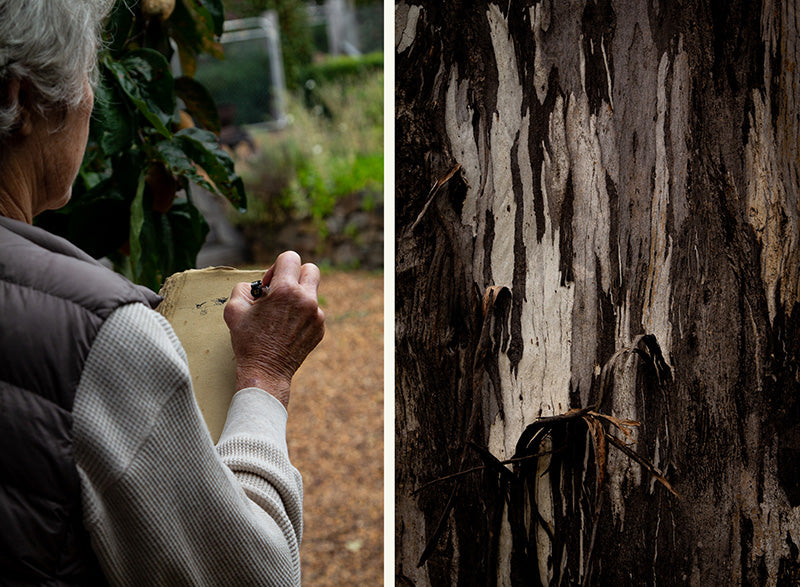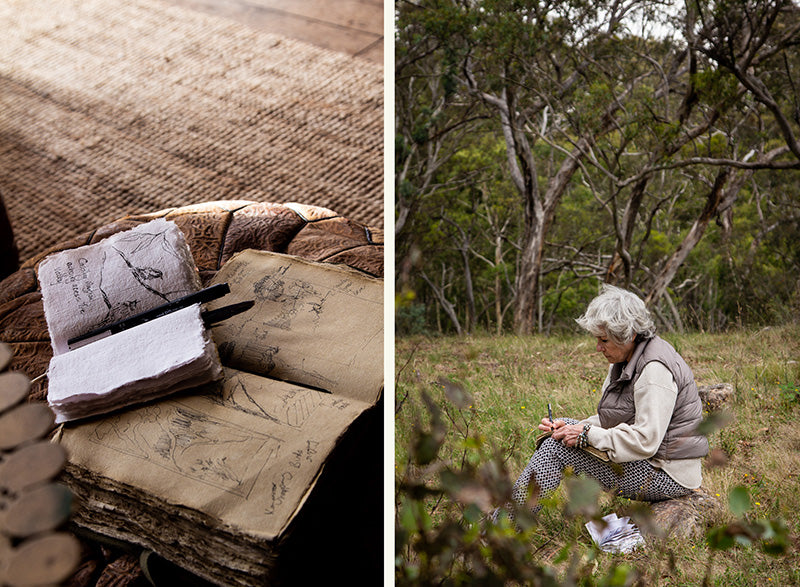An Artistic Sense | Julianne Ross Allcorn
It is with great excitement that we share our collaboration with the accomplished Australian artist, Julianne Ross Allcorn. Our latest scent Bush Magic was inspired by Julianne’s work, which is instantly recognisable as a richly layered expression of the mystical vibrancy found in the hidden flora and fauna of our native land.

From a tropical childhood in Papua New Guinea, where her love of drawing was ignited, to her flourishing art practice and teaching schedule that sees her travelling the world, Julianne’s tenacious approach to mark marking is scaffolded by her whip-sharp observation skills and a disciplined background in dance.
Sketchbooks are Julianne’s constant companion as the artist continuously captures and translates the sights, scents and sounds that appear before her. Attuned to the natural world from a young age and truly engaged in life on all sensory levels, Juli was a dream Southern Wild Co collaborator. Her stunning response to our brief is Into the Night, an evocative large scale pencil and watercolour piece that wraps the viewer up in the poetic mysticism of the Australian bush.
We sat down with Julianne to chat about her art journey and practice, as well as the beautiful collaboration with Southern Wild Co. Ever the teacher, Juli also imparts brilliant advice for emerging artists.


You grew up in Papua New Guinea and moved to Australia when you were 10. What were your first impressions of Australia?
We visited Australia every two years for extra schooling and holidays. Flying over Sydney from New Guinea at night was like looking down onto a fairyland of light and darkness.
When we moved here permanently, I went to a boarding school at Wenona, North Sydney, so I didn’t have a grasp of the wider natural landscape. The amount of green I grew up with on the tropical island was incredible, along with the bright flowers and heavy scents. Travelling to Europe when I was 23, I noticed the different energy and softer light. And then I started to notice Australia’s olive greens and tertiary colours. Yes, we have the viridian and deeper shades here, but our strong light bleaches the colour, and it makes you squint. It’s so different to anywhere else.
Has the desire to create always been with you?
I drew from a very early age. Always flowers. I think there’s something very delicate in them with so much detail that you can lose yourself within. Flowers are magic, with a softness in their petals and leaves, and I love recreating that on paper through the pressure I place on my pencil. I’ve become known for the detail of flora and fauna on boards, and when I do step away from that and try portraiture or still life, people say, oh that’s not Juli.
How did the boards come about?
Every time I drew on paper, I had to have it mounted and framed behind glass, and that’s a huge expense, which people weren’t always willing to pay. I don’t feel people value drawing as much as painting. They don’t think it is as important, even though drawing is often the first step in painting.
Drawing is such a textural, organic thing, so I was trying to find something I could draw on that didn’t need glass or frames. I found the Birchwood boards, and I thought they looked fun, so I tried one. A girlfriend said just make it bigger. One became two, three, and then nine. I can do a big landscape, but then I can do macro within that landscape. That’s when the layers started happening.
There’s perspective in my drawing, but there’s no perspective at the same time. I would like the viewer to go on a journey with me. If someone asks me about the work, I often say stay in front of it for a few minutes and look at everything at once – the colours, the way the foliage is moving, the birds. And then close your eyes, and listen for what you saw. You know you are in the landscape because you’ve looked and focused. You will find yourself trying to recreate what you would hear if you were walking through it.
Your sketchbooks are incredibly detailed and annotated with sensory elements like the sounds and fragrances, and I feel that comes out in your work.
That’s my reference. I have to write what I was hearing to take myself back to that moment in time. A photo doesn’t do that. It doesn’t capture the sounds or the smells. You’ve stood there to sketch it and write about it, so all your senses come alive because you are noticing.
When I was drawing a landscape this morning in my sketchbook, the sun was low and there were really long shadows and magpies were singing. And I will go back to make a big triptych of that. A wide landscape and then all the foliage creeping in, with the magpies.

Your work encapsulates so many stylistic influences from different eras, locations and art movements. What are your biggest influences, and how do they translate into the style you’ve become known for?
I think the biggest influence on me is Asian art and the use of negative space. If you look at a Chinese or Japanese screen or scroll you’ve got beautiful focused detail of a branch, bird or grasshopper, and they are moving, with a lovely splash of light, but next to that is all this air. It’s playing with the negative space, which gives you the place to breathe and the place to walk.
But then I love drawing detail, researching and watching the flora and fauna move in the landscape. For that I look to Australian artists and notice how they capture the landscape. Streeton and his colours, and Tom Roberts earthiness.
I am also inspired by Gustav Klimt and Egon Schiele. Especially Schiele, because of his sharp broken edges in his drawings. It’s so angular. If you draw a big gum nut, it doesn’t come down softly around – it’s all angled, and then falls into more angles. And then from this sharpness, you have the softness of the gum blossoms when they come out, like a gentle face brush. It’s magical.


You spent a lot of time on the road last year, drawing and teaching. Where did you go and what did you get up to?
Yes, there was a bit of travel in 2023! There was Vietnam, and then France and Burgundy where I was teaching and did a residency. Then Portugal and Spain, and back to Australia to head straight out to Alice Springs. Looking at the landscape in central Australia, I couldn’t put the height and width into perspective. It was so immense. I kept thinking, where am I? From there, I went to the Grampians, which again was crazy with the big mountains and hundreds of kangaroos and emus walking around. And then back to Sydney and teaching.
This year, you are collaborating with Southern Wild Co on very exciting projects, and we feel extremely lucky. We have our three-day drawing and watercolour painting workshop, The Hidden Landscape, beginning on 17 May, and you created the artwork for our new scent story, Bush Magic. What drew you to Southern Wild Co initially?
In 2020, I won the Trustees Watercolour Prize in the Wynne. I didn’t know Tania or Southern Wild Co at that time, but I found an article on the Southern Wild Co Journal about my work and I thought – this lady understands me! I started following on social media, and I just love the way Tania and Southern Wild Co are influenced by history, poetry, landscapes, and artists, and they incorporate that into all that they do. Tania and I have wonderful conversations.

In response to the Bush Magic brief, you created the incredible artwork ‘Into The Night’. How did the piece develop?
I begin any artwork with a main colour, flower and animal. For Southern Wild Co, it had to be dark, because it’s the story of the scent of Bush Magic, it is about the evening light and that slowness of the land going to sleep. And it was important to include a black cockatoo.
I chose banksia, because its so sculptural, and I knew we were going to include the cockatoos and also blue fairy wrens, with areas of black and shadow.
I started placing elements so it felt like a conversation happening in the bush. I left space in the middle so Tania could rework the piece into packaging design, but also, we needed the breathing space, because if you look out into the bush, it’s often all sky and wide expanse.
With your use of negative space and the way your elements are placed, you really get that sense of standing in the bush as it slowly reveals itself. You notice, piece by piece, the sounds and details that start to creep in. And you realise just how much is going on in the scene.
People say, it’s so quiet out in the bush, but it’s actually only quiet for those first 30 seconds because you’ve come from the car or have been hearing some other kind of white noise. When you start to really listen, you realise you are immersed in a range of completely different sounds. You can hear a beetle scuttling, the rustle of the wind, the crunch leaves if it’s dry or the squelch if it’s wet. And that flutter of birds. It’s so magical when you give yourself time to be still.
Even when I am not creating out in the bush, my studio at home is only two minutes away from a national park, and our very unorganised garden attracts birds and wildlife. An element of bringing the outside in runs through all of my work and practice.
How long did Into The Night take to complete?
I listen in the bush, make notes and sketch and play, but I am a quick worker. Once I start, Im in the studio for 8 or 9 hours, and I don’t stop. It’s a drawing with some watercolour, so I am not using oils or really thick brushes. My tools are fine-tip pencils and thin brushes. It’s intense when I begin, and I just go with the flow.
There was a time schedule on this one – I think I had a three-week turnaround, so I just went for hell! Then I had to get it to the framer, whom I have been using for 25 years. He knows how to work with my boards, which aren’t always perfect dimensions. Being wood, they will warp and move because they are organic and natural.

Congratulations on your Wynne-affiliated Trustees Watercolour Prize in 2022 and your repeated inclusions as a finalist in the Wynne and Archibald. How does recognition in such highly regarded art events influence your practice?
It’s a platform that can transform you from an unknown artist into someone known, and that was intense. Suddenly, I was propelled up, but it doesn’t matter how well-known you are; you are still you. I still teach students. I currently teach 80 students a week, from year three through to HSC and adults, and that’s very grounding. They have no problem saying, Juli, that painting just doesn’t gel; something’s wrong there. It’s levelling.
Being involved in the prizes put me out there, and the galleries are really supportive, so I thank them. I also thank all the people who have contacted me separately and bought artwork because the pieces made them feel special.
But the biggest thank you is to my family for the support they give. And to my mum, who knew from a very early age that I needed lessons. My first private lesson was when I was in New Guinea in primary school. She understood.
What advice on working as an artist can you share?
You will not be successful unless you are disciplined. You need to work every day because it won't come out of the blue. You have to be focused and patient and understand that failure is part of the process.
I have a background in dance, and without discipline, you can’t do anything. In classical ballet, you don’t go straight into allegro and pirouette, you start with a plié, or you do a stretch – you go through the steps in a disciplined way. It’s the same with a pencil. You aren’t going to make a masterpiece right away, but you will unwind and warm up as you sketch. It’s important to get yourself focused and in the moment and then go with it.
What does the rest of 2024 look like for you?
This year is full of workshops, like the one with Southern Wild Co! I have a solo exhibition at Michael Reid Southern Highlands in April and another at Maunsell Wickes in November in Paddington, and between all that, there are a number of private commissions. I’m also travelling to Africa. We are going to Nairobi for workshops with a primary school and the Uweza Art Gallery, and that was by invitation.
And my husband Paul and I are going camping in central Australia in July/August to absorb that landscape again and become the little ant on a very large canvas!
Find Julianne’s work on Instagram here.
Visit Michael Reed Southern Highlands 12 April – 19 May 2024.
...
